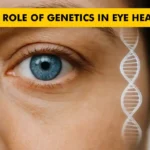High eye pressure, also known as increased intraocular pressure, occurs when the fluid inside the eye (aqueous humour) does not drain properly, causing a buildup of pressure. If left untreated, elevated eye pressure can lead to conditions such as glaucoma, which may even result in permanent vision loss.
This blog will explain the symptoms of high eye pressure, its causes, risk factors, effects on the eyes, and available treatment options. We’ll also address frequently asked questions and share insights into maintaining optimal eye health.
Understanding High Eye Pressure
The eyes maintain a delicate balance of fluid production and drainage to ensure proper function. When this balance is disrupted, it can result in increased intraocular pressure (IOP). While mild pressure changes may not immediately cause damage, consistently elevated eye pressure can harm the optic nerve, leading to glaucoma and vision loss.
Early detection, understanding the symptoms of high eye pressure, and seeking timely treatment are key to preventing long-term complications.
What is High Eye Pressure?
High eye pressure, medically termed ocular hypertension, occurs when the eye pressure exceeds the range of normal eye pressure.
The range of normal eye pressure is typically between 10 mmHg and 21 mmHg (millimetres of mercury). High eye pressure does not always cause optic nerve damage but increases the risk of developing it over time.
Causes of Elevated Eye Pressure
There are several risk factors and causes of elevated eye pressure:
- Imbalance in Fluid Production and Drainage: The eye produces aqueous humour, which drains through the trabecular meshwork. Blockage or slow drainage increases pressure.
- Eye Trauma or Injury: Physical injury can disrupt fluid regulation, leading to long-term pressure changes.
- Steroid Use: Prolonged use of steroid medications, including eye drops, can increase intraocular pressure.
- Genetics: Family history of high eye pressure or glaucoma increases your risk.
- Medical Conditions: Conditions like diabetes, hypertension, or autoimmune disorders can affect eye pressure.
- Ageing: The risk of elevated eye pressure increases with age.
Understanding these causes can help you take proactive measures to control and monitor eye pressure effectively. However, you must also be aware of its symptoms.
Symptoms of High Eye Pressure
The symptoms of high eye pressure are often subtle, and many people may not notice any signs until the pressure causes damage. However, you should watch out for the following symptoms:
- Eye discomfort or pain
- Blurred vision or difficulty focusing
- Halos around lights
- Headaches, particularly near the eyes
- Redness of the eye
- Decreased peripheral vision
If you experience these symptoms, consult an ophthalmologist immediately to measure your intraocular pressure and assess your eye health.
How Does High Eye Pressure Affect the Eyes?
When high eye pressure persists, it can have serious effects on eye health. Here’s how it impacts your eyes:
- Damage to the Optic Nerve: Increased pressure damages the nerve fibres, which can lead to permanent vision loss.
- Development of Glaucoma: High eye pressure is a major risk factor for glaucoma, a leading cause of blindness.
- Reduced Peripheral Vision: Pressure buildup often starts affecting side vision, which can progress to central vision loss.
- Corneal Damage: Excessive pressure can cause corneal swelling or cloudiness, resulting in blurred vision.
To prevent these complications, timely diagnosis and appropriate high eye pressure treatment are essential.
Treatment for High Eye Pressure
Any treatment for high eye pressure aims to reduce intraocular pressure and prevent damage to the optic nerve. Treatment methods may include:
Medicated Eye Drops
Prescription eye drops help lower intraocular pressure. Regular and consistent use is crucial for effectiveness.
Oral Medications
If eye drops alone do not reduce pressure, oral medications like carbonic anhydrase inhibitors may be prescribed to control fluid production.
Laser Treatment
Laser therapy improves fluid drainage and lowers eye pressure. Procedures such as:
- Laser Trabeculoplasty: Targets the trabecular meshwork to enhance drainage.
- Laser Cyclophotocoagulation: Reduces fluid production by targeting the ciliary body.
Surgical Intervention
In cases where medications and laser treatment are ineffective, surgical procedures may be required:
- Trabeculectomy: Creates a new drainage channel for the aqueous humour.
- Shunt Implants: Devices that help drain excess fluid from the eye.
Lifestyle Modifications
Certain lifestyle changes can support eye pressure management:
- Regular Exercise: Low-impact activities help regulate eye pressure.
- Avoid Excessive Caffeine: Large amounts of caffeine may increase IOP temporarily.
- Stay Hydrated: Drink water consistently throughout the day to avoid sudden fluid changes. Do not take excessive amounts of water in one go.
If you are at risk or experiencing any symptoms of high eye pressure, consult an experienced ophthalmologist for regular monitoring and personalized care. Early intervention can protect your vision and ensure lifelong eye health.
Have you been delaying an eye exam for quite some time? Book an Appointment with Centre for Sight in India!
Frequently Asked Questions
High eye pressure, also known as ocular hypertension, often doesn’t cause noticeable symptoms. However, some individuals may experience symptoms such as mild eye discomfort, headaches, or changes in vision. In severe cases, high eye pressure can lead to glaucoma, which can cause vision loss or blindness if left untreated.
To lower eye pressure, your ophthalmologist may recommend prescription eye drops, oral medications, laser therapy, or surgical procedures depending on the underlying cause and severity of the condition. Additionally, lifestyle changes such as maintaining a healthy diet, managing stress, and avoiding activities that increase intraocular pressure (such as heavy lifting or strenuous exercise) may help manage eye pressure levels.
t’s not recommended to check your eye pressure at home without proper equipment and training. Measuring eye pressure requires specialized instruments such as a tonometer, which is typically only available in a clinical setting. Regular eye examinations by an eye care professional are essential for monitoring eye health and detecting changes in eye pressure or other conditions.
High eye pressure is caused by an imbalance between fluid production and drainage in the eye. Factors include genetics, trauma, medical conditions, and prolonged steroid use.
High eye pressure can be managed with medicated eye drops, laser therapy, or surgical treatments. Consult an ophthalmologist for the best treatment plan.
Yes, with timely diagnosis and proper treatment, glaucoma progression can be slowed or stopped, preventing vision loss. Regular monitoring is essential.
The range of normal eye pressure is typically between 10 mmHg and 21 mmHg. Values above this range indicate elevated eye pressure.
Eye pressure above 21 mmHg is considered elevated, but persistent levels above 30 mmHg are particularly dangerous and may lead to optic nerve damage.
Eye pressure can sometimes reduce naturally through lifestyle changes like regular exercise and a balanced diet, but medical intervention is often necessary for sustained control.





